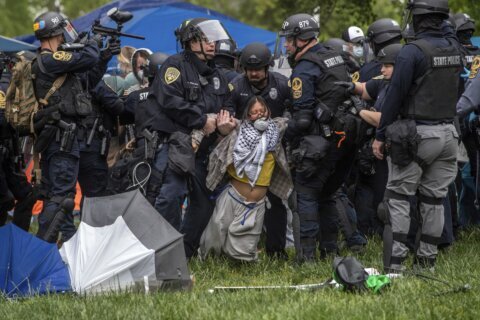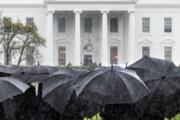Excerpts from recent editorials in the United States and abroad:
Nov. 18
The New York Times on the COVID learning loss:
In the thick of the Covid-19 pandemic, Congress sent $190 billion in aid to schools, stipulating that 20 percent of the funds had to be used for reversing learning setbacks. At the time, educators knew that the impact on how children learn would be significant, but the extent was not yet known.
The evidence is now in, and it is startling. The school closures that took 50 million children out of classrooms at the start of the pandemic may prove to be the most damaging disruption in the history of American education. It also set student progress in math and reading back by two decades and widened the achievement gap that separates poor and wealthy children.
These learning losses will remain unaddressed when the federal money runs out in 2024. Economists are predicting that this generation, with such a significant educational gap, will experience diminished lifetime earnings and become a significant drag on the economy. But education administrators and elected officials who should be mobilizing the country against this threat are not.
It will take a multidisciplinary approach, and at this point, all the solutions that will be needed long term can’t be known; the work of getting kids back on solid ground is just beginning. But that doesn’t mean there shouldn’t be immediate action.
As a first step, elected officials at every level — federal, state and local — will need to devote substantial resources to replace the federal aid that is set to expire and must begin making up lost ground. This is a bipartisan issue, and parents, teachers and leaders in education have a role to play as well, in making sure that addressing learning loss and other persistent challenges facing children receives urgent attention.
The challenges have been compounded by an epidemic of absenteeism, as students who grew accustomed to missing school during the pandemic continue to do so after the resumption of in-person classes. Millions of young people have joined the ranks of the chronically absent — those who miss 10 percent or more of the days in the school year — and for whom absenteeism will translate into gaps in learning.
In the early grades, these missing children are at greater risk of never mastering the comprehension skills that make education possible. The more absences these students accumulate, the more they miss out on the process of socialization through which young people learn to live and work with others. The more they lag academically, the more likely they are to drop out.
This fall, The Associated Press illustrated how school attendance has cratered across the United States, using data compiled in partnership with the Stanford University education professor Thomas Dee. More than a quarter of students were chronically absent in the 2021-22 school year, up from 15 percent before the pandemic. That means an additional 6.5 million students joined the ranks of the chronically absent.
The problem is pronounced in poorer districts like Oakland, Calif., where the chronic absenteeism rate exceeded 61 percent. But as the policy analyst Tim Daly wrote recently, absenteeism is rampant in wealthy schools, too. Consider New Trier Township High School in Illinois, a revered and highly competitive school that serves some of the country’s most affluent communities. Last spring, The Chicago Tribune reported that New Trier’s rate of chronic absenteeism got worse by class, reaching nearly 38 percent among its seniors.
The Times reported on Friday that preliminary data for 2022-23 showed a slight improvement in attendance. However, in some states, like California and New Mexico, “the rate of chronic absenteeism was still double what it was before the pandemic.” The solutions are not simple. There is extensive evidence that punitive measures don’t work, so educators may need a combination of incentives and measures to address the economic and family issues that can keep children away from school.
Researchers have long known that American students grow more alienated from school the longer they attend — and that they often fall off the school engagement cliff, at which point they no longer care. This sense of disconnection stems from a feeling among high school students in particular that no one at school cares about them and that the courses they study bear no relationship to the challenges they face in the real world.
These young people are also vulnerable to mental health difficulties that worsened during the pandemic. Based on survey data collected in 2021, the Centers for Disease Control and Prevention reported this year that more than 40 percent of high school students had persistent feelings of sadness and hopelessness; 22 percent had seriously considered suicide; 10 percent reported that they had attempted suicide.
Since the beginning of the pandemic, many parents and educators have been raising the alarm about the effects of grief, isolation and other disruptions on the mental health of their children. In addition to reconnecting these young people to school, states and localities need to create a more supportive school environment and provide the counseling services these students need to succeed.
The State of Virginia took a big swing at the problem of learning loss when it announced what is being described as a statewide tutoring program. But high-impact tutoring is labor intensive and depends on high-quality instruction. It is most likely to succeed when sessions are held at least three times a week — during school hours — with well-trained, well-managed tutors working with four or fewer students at a time. Such an effort would require a massive recruitment effort, at a time when many schools are still struggling to find enough teachers.
While tutoring is a step in the right direction, other measures to increase the time that students spend in school — such as after-school programs and summer school — will be required to help the students who have fallen furthest behind. In some communities, children have fallen behind by more than a year and a half in math. “It is magical thinking to expect they will make this happen without a major increase in instructional time,” as the researchers Tom Kane and Sean Reardon recently argued.
A study of data from 16 states by the Center for Research on Education Outcomes at Stanford University shows that the most effective way to reverse learning loss is to increase the pace at which students learn. One way is by exposing them to teachers who have had an extraordinary impact on their students. The center proposes offering these excellent teachers extra compensation in exchange for taking extra students into their classes. Highly trained, dedicated teachers have long been known to be the most reliable path to better educational outcomes, but finding them at any scale has always been difficult. If creative solutions can be found, it will help reverse learning gaps from the pandemic and improve American education overall.
The learning loss crisis is more consequential than many elected officials have yet acknowledged. A collective sense of urgency by all Americans will be required to avert its most devastating effects on the nation’s children.
ONLINE: https://www.nytimes.com/2023/11/18/opinion/pandemic-school-learning-loss.html
___
Nov. 17
The Wall Street Journal on an 81-year-old Joe Biden running for reelection:
If President Biden’s birthday Monday is anything like his last one, he’ll eat a cake quietly with family and hope nobody else notices. When he turned the big 80 last fall, the White House arranged a marriage as a distraction for the press. Mr. Biden’s granddaughter was wed on the South Lawn. The timing “was not a coincidence,” two sources told CNN.
Regardless, voters have managed to notice that Mr. Biden is showing his years. Seventy-seven percent of Americans say he’s too old for another term, according to an August AP poll, including 69% of Democrats, 74% of independents, and 89% of Republicans. And who says Mr. Biden hasn’t united the country? During the 2020 election, concerns about his age were muttered sotto voce, but now they’re front and center in his re-election bid.
Next week Mr. Biden will be 81. Already he is struggling on camera and limiting his public schedule. His aides fear he might trip—again—on TV. “Biden will not be able to govern and campaign in the manner of previous incumbents,” Politico reported this week. “He simply does not have the capacity to do it, and his staff doesn’t trust him to even try.”
Then why is he asking the public to keep him in the Oval Office until 2029, when he will be 86 years old? If he can’t take the rigors of a presidential campaign, why would voters think he can handle four more years of a grueling job, which might include being shaken awake in the wee hours to respond to a Chinese invasion of Taiwan?
Given Mr. Biden’s age and obvious decline, running for re-election is an act of profound selfishness. He has wanted the big desk since at least 1987, when he first ran. Aging people, even if they’re not surrounded by yes men, can be the last to notice time’s toll, as many can attest after trying to take away dad’s car keys.
Mr. Biden wants to run another Wilmington basement campaign, albeit this time from the White House. But the polls are screaming that his weakness could put Donald Trump back into office. Even if Mr. Biden wins, there’s a strong chance the country would get President Kamala Harris before his term ends.
The White House has tried to laugh away such worries. As press secretary Karine Jean-Pierre once memorably put it: “Eighty is the new 40. Didn’t you hear?”
This won’t work, especially when Mr. Biden’s aides are whispering to the press that they don’t trust him on the campaign trail. His staff and family should put the country before the perks of office. If the reality is that the boss is too old for another term, and if he refuses to hear it, the honorable move is to resign and quit covering for him.
___
Nov. 20
The Wall Street Journal on censure, expulsion or reprimand of lawmakers:
Ideally, a House member credibly accused of as much cartoonish criminality as Rep. George Santos (R-N.Y.) would resign, if only to spare himself the humiliation of having his colleagues expel him. That was the norm in bygone eras, which is partly why the body has had to expel only two members since the Civil War. But Mr. Santos refuses to go, though he has said he won’t run for reelection. This leaves the House no option but to make him the third.
With Donald Trump-style refusal to acknowledge wrongdoing — let alone resign — becoming the new norm, Congress is likely to have to formally punish more of its members. It has four disciplinary measures: expulsion, censure, fine and reprimand. Sadly, lawmakers now need consistent standards for each, lest they be applied inconsistently across parties and Congresses.
Expulsion should be saved for the most egregious transgressions and considered only once the accused has due process, preferably — though not necessarily — in court. Mr. Santos survived an expulsion vote earlier this month when 31 Democrats joined 182 Republicans to vote no, on the principled grounds that neither a House Ethics Committee investigation nor his impending federal fraud trial had concluded. On Nov. 16, however, the Ethics Committee released a damning report documenting how “Santos sought to fraudulently exploit every aspect of his House candidacy for his own personal financial profit.” Committee Chairman Michael Guest (R-Miss.) introduced a resolution to expel Mr. Santos, and it ought to receive the necessary two-thirds majority after Thanksgiving.
Ethics Committees, wary of influencing trials, have historically been reluctant to act until the legal process ends. And even a conviction, if obtained under dubious circumstances, might not warrant expulsion. Neither reservation, however, seems applicable to Mr. Santos — a fabulist who lied to the effect that his grandparents were Holocaust survivors and his mother was in the World Trade Center on Sept. 11, 2001. Especially relevant to this situation, he lied by claiming he was cooperating fully with the ethics probe. In fact, he was stonewalling.
Censure ranks below expulsion in the disciplinary hierarchy. After censuring just six members in the 20th century, the House has slapped that scarlet letter on three members in three years. The latest was Rep. Rashida Tlaib (D-Mich.), who, according to a bipartisan majority of her colleagues, was guilty of “calling for the destruction of the state of Israel and dangerously promoting false narratives regarding a brutal, large-scale terrorist attack” by Hamas on Oct. 7. In June, Republicans censured Rep. Adam B. Schiff (D-Calif.) on a party-line vote for accusing Mr. Trump of colluding with Russia. Two years ago, Democrats censured Rep. Paul A. Gosar (R-Ariz.) for tweeting an anime video that depicted him killing Rep. Alexandria Ocasio-Cortez (D-N.Y.).
Historically, however, members had been censured for deeds, not words: molesting teenage pages, pocketing bribes and selling military academy appointments. (In hindsight, these offenses merited expulsion.) It would be better for Congress to revert to that norm before an inevitably partisan tit-for-tat denunciation of speech becomes established practice. By that standard, neither Mr. Schiff, Mr. Gosar nor Ms. Tlaib should have been censured.
A more appropriate remedy for Ms. Tlaib would have been a reprimand, which, like censure, also requires a simple majority vote. That’s what Rep. Joe Wilson (R-S.C.) got when he heckled President Barack Obama in 2009. Another potential punishment is to remove a lawmaker from committee assignments. Mr. Santos voluntarily gave up his committees in January. But it takes a House vote to do it to a member of the opposition party if their leaders won’t. That’s what Democrats did in 2021 to Mr. Gosar and Rep. Marjorie Taylor Greene (R-Ga.), who peddled QAnon conspiracy theories. But both Mr. Gosar and Ms. Greene received committee assignments when the GOP took control in January.
With only a four-vote majority, Republicans who vote to remove one of their own will be engaging in a rare consequential action against partisan interest. Senate Democrats should find the same courage to censure Sen. Bob Menendez (D-N.J.), who is under federal indictment for allegedly taking cash and gifts for aiding the Egyptian government between 2018 and 2022. (He has pleaded not guilty.) He was previously “admonished” in 2018 by the Senate Ethics Committee — a penalty unique to the upper chamber — after a jury deadlocked on charges he used his office to advance a personal benefactor’s interests. The current charges seem stronger than those he beat five years ago. Still, the possibility he won’t be convicted — along with the impending opportunity, next November, for voters to judge him at the polls — argue against expulsion.
Whatever the outcome of Mr. Menendez’s criminal case, or Mr. Santos’s, their conduct — by any standard — has brought discredit on Congress.
___
Nov. 17
The Los Angeles Times on debate at U.S. universities:
At moments like this, when violence in the Middle East has reached a fever pitch that has left the world horrified, universities have an important role to play in convening open debate. Or at least they used to.
The past weeks could have been the perfect time for relevant learning on the Israel-Hamas conflict, an antidote to the extraordinary campus strife we are seeing at the University of California and elsewhere across the nation. Instead of painting others as the enemy, people might have searched for common ground, or at least deeper understanding.
Institutions of higher education could have called on their experts, such as those in history, geography, international relations and religion to hold seminars and teach-ins for students and community members. They could have organized talks and speaker panels in which people listened to each other instead of belittling and insulting those with different backgrounds and views. How many people, after all, truly know the history and understand the current politics of the Middle East?
This is a big part of what students should be getting out of college: deep learning, shaped by debate and discussion, leading to informed opinion. Unfortunately, as the roiling accusations and fears on U.S. colleges campuses show, that has become hard to achieve.
When did universities become places where people started conversing less and expressing open hostility more?
There are no easy answers, of course. During the 1960s and 1970s, there were plenty of campus demonstrations and even violence. Each era has its own form of protest and passions. Society changes and so does conduct in many institutions.
The American Assn. of University Professors believes that free discussion became more easily chilled about a decade ago, when some students began calling for trigger warnings before classroom discussions of topics they might find upsetting; that led to demands that faculty members provide trigger warnings on assigned literature.
The flood of social media, often created to fuel outrage, and political polarization during the Trump era certainly haven’t nurtured civility.
No wonder that when faced with gut-wrenching news like the Israel-Hamas war, many students react in hostile ways that chill the speech of others and make their fellow students feel threatened. Unfortunately, in some cases, their professors do the same or worse.
Vehement student protest has a time-honored place on campus. Students should be angry about injustice; how else will they fight it? But protest should be based on verified information, and should lead to discussion devoid of vituperative insults, harassment or threatening language. The opposing factions might not end up agreeing; in fact, they probably won’t. But they may end up with a deeper understanding of each other’s views and becoming better informed.
Instead of helping students reach that point, many universities and even departments within them have been staking out positions on one side or another of the Mideast debate. It’s unhelpful at best. If a university or academic department says it stands behind Israel, Palestinian students feel unwelcome at their own school; if the department berates Israel or casts doubts on its right to exist, Jewish students feel hated by their professors and threatened on campus.
Earlier this week, University of California President Michael Drake rightly put it this way: “The war in Israel and Gaza presents a complex set of intersecting issues that require multiple solutions on multiple fronts. Today we are doubling down on who we are: an educational institution that’s guided by facts and data, but also a moral compass that helps us find our way to compassion and understanding in difficult moments.”
UC will spend $2 million on education programs to foster better understanding of antisemitism and Islamophobia and to teach students about the history of the Middle East. An equal amount will go to teach UC leaders and staff on how to be true educators and helpers.
Drake has shown the way. With luck, his example will lead universities back to their critical mission of convening informed, intelligent and inclusive discussion about the most difficult issues facing the world.
___
Nov. 17
China Daily on the meeting between US President Joe and Chinese President Xi Jinping:
Ahead of the meeting between the two heads of state, the US president expressed, in public at least, low expectations of his first face-to-face talks in a year with Chinese President Xi Jinping.
Before departing for San Francisco, asked about his yardstick for success, US President Joe Biden said, “To get back on a normal course of corresponding, being able to pick up the phone and talk to one another when there’s another crisis”.
Their four hours of talks having produced agreement on that and more, the US leader was notably more upbeat about the meeting afterward.
“I believe they were some of the most productive and constructive discussions we’ve had,” he declared. That the two leaders exchanged views in an atmosphere of mutual respect has obviously been conducive to generating the buzz of positivity that both sides have exhibited after the talks.
Summarizing the significant progress that had been made in the two leaders’ discussions that were “good, comprehensive and in-depth”, Chinese Foreign Minister Wang Yi said that the summit would be seen as a milestone in the history of US relations.
Indeed, anyone worried about what has been a continuous downward spiral of the two countries will now be heaving a sigh of relief, as the constructive engagement the two leaders committed to should, if nothing else, arrest the deterioration in bilateral relations. So long, of course, as the US side holds true to the “tangible steps in the right direction” the talks have produced, something it found difficult to do after their previous meeting in Bali because of the anti-China caucus in the US Congress.
In the absence of a joint statement, it remains to be seen how much the two sides’ opinions converge on the Chinese president’s proposal that the countries assume a “new vision” for their relationship based on them making the right choice of cooperation rather than confrontation.
Stating that it is unrealistic for either country to change or lay down the law for the other, Xi proposed the two countries build “five pillars” to support stable, healthy and sustainable relations. He proposed that the two sides jointly establish correct perceptions of each other, effectively manage their differences, promote mutually beneficial cooperation, assume their responsibilities as major countries, and promote people-to-people exchanges.
That there were perceptible agreements reached, such as the reinstatement of direct military-to-military communication, shows that building these pillars is doable. That was reinforced by the joint climate statement the two countries’ climate negotiators issued on Tuesday, which has “added a driving force for the China-US relationship to stop falling and begin stabilizing”, as Xinhua News Agency observed, and is heartening news ahead of the upcoming UN climate summit in Dubai later this month.
All in all, the summit as Wang Yi said, can have far-reaching influence as the two leaders put forward guiding opinions on the most prominent issues in bilateral relations and set out the future-oriented direction for the two countries to get along.
ONLINE: https://www.chinadaily.com.cn/a/202311/16/WS6555fe37a31090682a5ee971.html
Copyright © 2024 The Associated Press. All rights reserved. This material may not be published, broadcast, written or redistributed.







